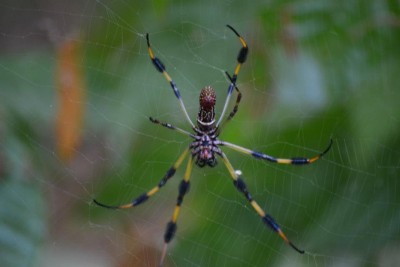NSU Newsroom
SharkBytes
Horizons
This version of NSU News has been archived as of February 28, 2019. To search through archived articles, visit nova.edu/search. To access the new version of NSU News, visit news.nova.edu.
This version of SharkBytes has been archived as of February 28, 2019. To search through archived articles, visit nova.edu/search. To access the new version of SharkBytes, visit sharkbytes.nova.edu.
Have you Seen this Eight-Legged Monster on Campus?
The golden silk orb-weaver (Nephila clavipes), also known as the banana spider, is the largest non-tarantula in North America. Despite their menacing appearance, these spiders are not dangerous and won’t bite unless handled or squeezed. In fact, most orb-weavers have very poor vision, remain in their webs and feed on bees and dragonflies.
A banana spider’s web can reach up to six feet in diameter and their bodies (including their legs) can grow to be as big as your hand. If you’ve explored any of our local natural areas, you might have noticed that the ones on campus are even bigger than those in the wilderness. You wouldn’t be wrong.
In their recently published paper, “The successful exploitation of urban environments by the golden silk spider, Nephila clavipes (Araneae, Nephilidae),” Halmos College faculty members Paul Arena, Ph.D. and Omar Eldakar, Ph.D., along with Halmos alumnus Jacob Ripp, B.S., describe the differences in size of Nephilia clavipes living in urban and natural areas.
Their research on female banana spiders living in South Florida supports similar findings from a close relative in Australia, that spiders are larger in urban areas than nearby natural areas. While the reason for this difference in size is not yet known, it’s among one of the questions that Halmos College faculty plan on looking into.
https://academic.oup.com/jue/article/4/1/juy005/4970059
